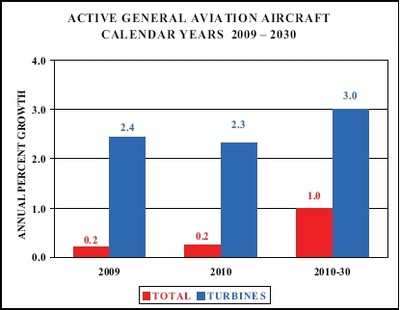"Active" Fleet Will Increase 0.9 Percent By 2030
 The FAA's 20 year Aerospace Forecast predicts that the GA
active fleet will grow, but only modestly, over the next 20 years,
and the fleet of piston singles and twins will likely shrink in the
near term before expanding again in the out years of the period.
The category includes forecasts for the fleet and hours flown for
single-engine piston aircraft, multi-engine piston, turboprops,
turbojets, piston and turbine powered rotorcraft, light sport,
experimental and other, such as gliders and lighter than air
vehicles. An "active" aircraft is defined by the FAA as one that
flies at least once per year.
The FAA's 20 year Aerospace Forecast predicts that the GA
active fleet will grow, but only modestly, over the next 20 years,
and the fleet of piston singles and twins will likely shrink in the
near term before expanding again in the out years of the period.
The category includes forecasts for the fleet and hours flown for
single-engine piston aircraft, multi-engine piston, turboprops,
turbojets, piston and turbine powered rotorcraft, light sport,
experimental and other, such as gliders and lighter than air
vehicles. An "active" aircraft is defined by the FAA as one that
flies at least once per year.
The report indicates that the active general aviation fleet
(chart, below) is projected to increase at an average annual
rate of 0.9 percent over the 21-year forecast period, growing from
an estimated 229,149 in 2009 to 278,723 aircraft by 2030. The more
expensive and sophisticated turbine-powered fleet (including
rotorcraft) is projected to grow at an average of 3.0 percent a
year over the forecast period, with the turbine jet portion
increasing at 4.2 percent a year.

FAA Chart
The number of active piston-powered aircraft (including
rotorcraft) is projected to decrease from the 2008 total of 166,514
through 2017, with declines in both single and multi-engine fixed
wing aircraft, but with the smaller category of piston-powered
rotorcraft growing. Beyond 2017 active piston-powered aircraft are
forecast to increase to 172,613 by 2030. Over the forecast period,
the average annual increase in piston powered aircraft is 0.2
percent. Although piston rotorcraft are projected to increase
rapidly at 3.4 percent a year, they are a relatively small part of
this segment of general aviation aircraft. Single-engine fixed-wing
piston aircraft, which are much more numerous, are projected to
grow at a much slower rate (0.2 percent respectively) while
multi-engine fixed wing piston aircraft are projected to decline
0.8 percent a year. In addition, it is assumed that VLJs and new
light sport aircraft could erode the replacement market for
traditional piston aircraft at the high and low ends of the market
respectively.
Starting in 2005, a new category of aircraft (previously not
included in the FAA’s aircraft registry counts) was created:
“light sport” aircraft. At the end of 2008 a total of
6,811 active aircraft were estimated to be in this category while
the forecast assumes the fleet will increase approximately
825 aircraft per year until 2013. Thereafter the rate of increase
in the fleet tapers considerably to about 335 per year. By 2030 a
total of 16,311 light sport aircraft are projected to be in the
fleet.
The FAA says the advent of a relatively inexpensive twin-engine
very light jet (VLJ) raised a lot of questions regarding the future
impact they may have. The lower acquisition and operating costs of
VLJs were believed to have the potential to revolutionize the
business jet market, particularly by being able to sustain a true
on-demand air-taxi service. While initial forecasts called for over
400 aircraft to be delivered a year, events such as the recession
along with the bankruptcy of Eclipse and DayJet have led the FAA to
temper more recent forecasts.

FAA Chart
The report indicates that the number of general aviation hours
flown (chart, above) is projected to increase by 2.5 percent
yearly over the forecast period. A large portion of this growth
will occur in the short term post recession period, where record
low utilization rates experienced in 2009 will return to normal
trends, particularly in the turbine jet category. As with
previous forecasts, much of the long term increase in hours flown
reflects strong growth in the rotorcraft and turbine jet category.
Hours flown by turbine aircraft (including rotorcraft) are forecast
to increase 4.1 percent yearly over the forecast period, compared
with 1.1 percent for piston-powered aircraft. Jet aircraft are
forecast to account for most of the increase, with hours flown
increasing at an average annual rate of 6.1 percent over the
forecast period. The large increases in jet hours result mainly
from the increasing size of the business jet fleet, along with
measured recovery in utilization rates from recession induced
record lows. Rotorcraft hours, relatively immune to the economic
downturn when compared to other categories, are projected to grow
by 3.0 percent yearly. The light sport aircraft category is
expected to see increases in hours flown on average of 5.9 percent
a year, which is primarily driven by growth in the fleet.
 ANN's Daily Aero-Linx (04.13.24)
ANN's Daily Aero-Linx (04.13.24) ANN's Daily Aero-Term (04.13.24): Beyond Visual Line Of Sight (BVLOS)
ANN's Daily Aero-Term (04.13.24): Beyond Visual Line Of Sight (BVLOS) Airborne 04.09.24: SnF24!, Piper-DeltaHawk!, Fisher Update, Junkers
Airborne 04.09.24: SnF24!, Piper-DeltaHawk!, Fisher Update, Junkers Aero-News: Quote of the Day (04.14.24)
Aero-News: Quote of the Day (04.14.24) ANN's Daily Aero-Term (04.14.24): Maximum Authorized Altitude
ANN's Daily Aero-Term (04.14.24): Maximum Authorized Altitude





